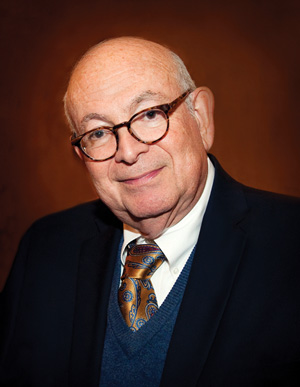B’nai Amoona played pivotal early role in local Jewish history
Published June 18, 2014
Congregation B’nai Amoona, which for years had the largest membership of any local Conservative synagogue, had its origins as a German-Jewish Orthodox shul named Sheareth Israel (Remnants of Israel), according to local historians Rosalind Mael Bronsen in her book “B’nai Amoona for All Generations” and the late Walter Ehrlich in his two-volume history of the St. Louis Jewish community, “Zion in the Valley.”
Bronsen, who had a doctorate in history from the University of California-Los Angeles,wrote in her 1982 book: “Somewhere between shadow and history lie the beginnings of Congregation B’nai Amoona.§
The first contemporary references to the small assemblage of Orthodox Jews are found in the St. Louis Post-Dispatch in a piece published Aug. 15, 1884. It describes “a concert for the benefit of Rev. Aaron Levy, the Jewish rabbi whose congregation seceded recently from Sheareth Israel Church (sic), will be given at Druid’s Hall, Aug. 17. The congregation now worships regularly at Pohlman’s Hall, Broadway and Franklin Avenue, under the name B’nei Emounoh, which means ‘Sons of Faith.’ ”
ADVERTISEMENT
Later items in the Post-Dispatch included anOct. 31, 1884, item noting that the congregation the following month would start worshipping in the hall at Ninth Street and Washington Avenue: “The congregation which formed in July with 32 members now numbers 97 and $500 is the snug balance in the treasury.”
Then, on Jan. 16, 1885, the Post reported, “Rev. Aaron Levy who resigned as pastor of Bene Amoon Congregation, has been succeeded by Rev. A. (Adolph) Rosentreter, who recently arrived from Berlin.”
In the 19th century, rabbis were often referred to as reverends and pastors in Israelite churches in the general media.
ADVERTISEMENT
The conclusion that B’nai Amoona was founded in July 1884 by a group that brokeaway from an older Orthodox congregation called Sheerith Israel is bolstered by an article by Rabbi Rosentreter in 1925, which states that on Aug. 2, 1884, 17 men met in a room over a millinery shop at 721 Franklin Avenue to form Congregation B’nai Amoona.
Conflicting accounts of the precise date of founding, lists of founders and other historical facts are fairly typical of local Jewish congregations.
“The minor discrepancies in these two accounts regarding dates, locale and the initial number of members do not seriously alter the picture,§Bronsen writes.
Some synagogues date their “founding” to the first minyan, as was the case with United Hebrew. Others date the “origin” to the issuance of a formal and officially approved “charter.”
Bronsen and Ehrlich note the “German-Jewish” origins of B’nai Amoona and point out that its original founders were immigrants from Krakow. Both Sheerith Israel and its spinoff, B’nai Amoona, for many years were referred to as the Krakower Shul.
Ehrlich writes: “What all these people (the founders of the first generation of Sheerith Israel and B’nai Amoona) had in common was their adherence to Orthodox Judaism and the German language. ’
“That B’nai Amoona was a congregation of German Jews undoubtedly explains its longstanding cordial relations with the Reform congregations of St. Louis, who demonstrated considerably different attitude toward institutions created by Eastern European Slavic immigrants.In fact a &committee on congregational cooperation* made up of members and rabbis of United Hebrew, B’nai El, Shaare Emeth and Temple Israel and B’nai Amoona, then Orthodox, even met periodically to deal with matters of mutual concern. No other Orthodox congregations were included.§
B’nai Amoona and Shaare Emeth were neighbors when their synagogue buildings were located in University City at Trinity Avenue and Delmar Boulevard, a geographic fact that reinforced the previously established cordial relations between the two large congregations.
It was only a natural progression, then,that led to Congregation B’nai Amoona moving from identifying as Orthodox to formally joining the Conservative Jewish movement.
“Conservative Judaism can be seen as an American phenomenon,” Bronsen writes. “It was a direct response to conditions prevailing in the United States at the end of the 19th century. Reform Judaism, which was the overwhelmingly dominant force among American Jews before its massive Eastern European immigration, had been undergoing a process of increasing radicalization. This culminated in the Pittsburgh Platform of 1885, which rejected all laws and ceremonies not adapted to the views and habits of modern civilization.”
In a strong backlash against the radical Reform of the Pittsburgh Platform, which essentially did away with the Jewish dietary laws, wearing of the kippah and tallis and a total rejection of seeking to establish a Jewish State, “moderate spiritual and lay leaders banded together to establish” an alternative to the radical-Reform Hebrew Union College. The result was the Jewish Theological Seminary of America, which opened in 1887.
Rabbi Abraham E. Halpern, a graduate of the Jewish Theological Seminary, who is credited with bringing Conservative Judaism to St. Louis and B’nai Amoona, wrote, “The B’nai Amoona stands for Conservative Judaism.”
Thus were the origins of both Congregation B’nai Amoona and Conservative Judaism in St. Louis.















